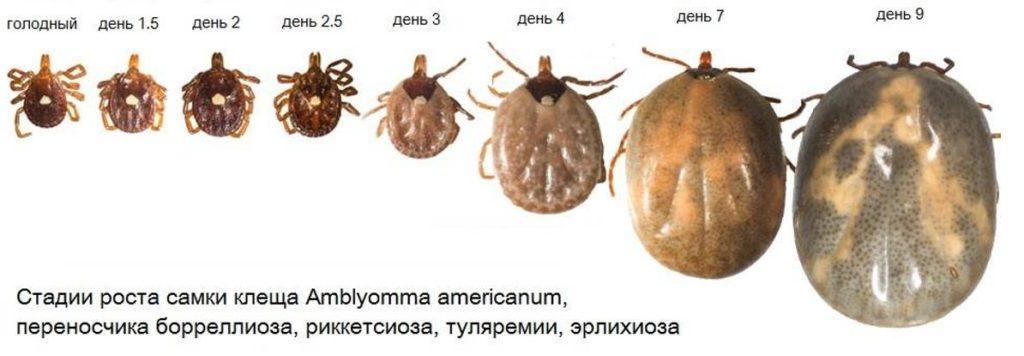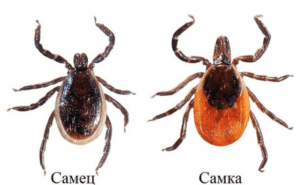The life cycle of a tick: how the forest "bloodsucker" breeds in nature
Currently, there is a spread of ticks beyond the range of their natural habitat. A few decades ago, this parasite could only be encountered in the forest, now they are increasingly attacking people and animals in city parks and summer cottages. One of the reasons for this is the fact that tick reproduction is a rapid process.
Content
How do ticks reproduce
The breeding process depends on their habitat and the amount of available nutrients. Most often, mating occurs in early spring, for this insects choose an available environment. After that, the female begins to actively look for a new breadwinner for herself, since during this period she needs to consume a lot of nutrients.

What is the difference between a female tick and a male
The reproductive system of ticks develops at the last stage of their life cycle, before turning into adults. Outwardly, males and females are very similar to each other, but the female can be distinguished by size: it is slightly larger than the male.
The structure of the genital organs of different individuals
Ticks have no external sexual characteristics. The female reproductive system consists of the following organs:
- vagina;
- seminal receptacle and glands;
- oviducts;
- unpaired ovary;
- uterus.
- spermatophore (it contains spermatozoa);
- ejaculatory canal (constantly located inside, output at the time of mating);
- paired testes;
- seed outlets;
- seminal vesicle;
- accessory glands.
Ticks lay eggs gradually, at a time the female can lay only one egg. This is due to the size of its internal organs.
Features of reproduction
Females live slightly longer than males, they die after laying eggs. After mating, the female must drink enough blood: she needs a volume that is 3-5 times her body size. Having satiated, the female looks for a suitable place, processes the blood and carries out laying. The role of the male is the transfer of genetic material. After mating, the male tick dies.
Animals on which forest mites breed
Forest parasites can breed on any animal, regardless of their size. Most often, their victims are mouse-like rodents: voles, forest mice, and so on. Sometimes ticks choose larger hosts: wild boars, elks. Sedentary birds are also a favorite habitat for parasites.
Life cycle
There are several varieties of ticks: they differ in the type of behavior, eating habits, and have external differences. However, they all go through the same stages of development and have the general character of the transformation of young individuals into adults.
Marriage period
Insects can reproduce only after full saturation, therefore, during the mating season, the main role is played not by the presence of a partner, but by the ability to get food. Parasites begin to multiply actively with the onset of spring, which is why the highest tick activity is observed during this period - they constantly need to replenish their need for nutrients and energy.
Masonry
After saturation and fertilization, female ticks begin to lay eggs.
Tick embryo development
After the death of the female individual, an embryo begins to develop in each egg. This process can take a different amount of time: from several weeks to several months. The process of embryo formation is influenced by external factors: average daily temperature, daylight hours, humidity.
If laying occurred in late autumn, the eggs can overwinter, and the embryo will continue its development with the onset of spring.
Larval development
During the first few days of life, tick larvae are on the litter and are not active.
| The first stage of development | At the beginning of this stage of development, a protective shell is finally formed in them, the individual grows and is not yet dangerous for humans and animals. |
| Limb development | Even if the larva accidentally falls on a potential host, it will not stick. A characteristic feature of individuals during this period of development is the presence of 3 pairs of legs, while adults have 4 pairs. |
| Power start | After the larva has gained strength and reached a certain level of development, it goes in search of food. Most often, the larvae penetrate into the habitats of rodents and birds. |
| Molting | After the larva is satiated, the next stage begins in its life - molting. During this period, the protective shell disappears and the chitinous shell forms, and the fourth pair of legs also appears. |
Development of the nymph
The nymph differs from the adult only in the absence of a reproductive system - during this period it is just beginning its development. Also at this stage, the development of a new cuticle, limbs and weight gain. The period lasts only a day, at this time the tick also needs to actively eat.
After the insect is satiated, the stage of the next molt begins. If the period fell on the cold season, the tick may hibernate and continue its development in the spring. After that, the tick turns into an adult - an imago.
The described periods of development are typical for ixodid and argas ticks, all the rest go through two stages: embryo - nymph or embryo - larva.
Lifespan and number of eggs
The life expectancy of insects depends on the climatic conditions in which they live, as well as on their species. For example, ixodid ticks can live 2-4 years, while microscopic mites live only a few months.
During the life cycle, the female can lay from 100 to 20 thousand eggs.
Tick feeding styles
Ticks are usually divided according to the type of food into single and multi-host. The eating habits of a tick are determined by its species, and at its discretion, it cannot rearrange itself and choose a different scheme.
single host
Such individuals prefer to live on the body of one owner. These parasites live permanently on the body of a warm-blooded creature, where they mate and lay eggs. These species include scabies and subcutaneous mites. In rare cases, if an insect experiences severe hunger and cannot find a biologically suitable individual, it may go in search of another host.
multi-host
This group includes parasites that choose any warm-blooded creatures as victims. In the early stages of development, parasites most often choose small rodents, and later they look for a larger host. Also, ticks are called multi-host, which do not specifically look for a source of food, but attack any animal that is in the area accessible to it.
Can a tick larva be contagious if it has never bitten anyone before a person?
Ticks are quite viable and dangerous insects. The main danger is represented by individuals that have reached the adult stage, young individuals are less active and rarely attack humans, but there is still a risk of infection from them.
Previous